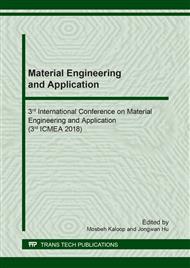[1]
P. Mehta and P. Monteiro, Concrete: microstructure properties and materials., USA: McGraw-Hill, (2006).
Google Scholar
[2]
B. Damineli, F. Kemeid, P. Aguilar and V. John, Measuring the eco-efficiency of cement use. Cem. Concr. Comp. 32(8) (2010) 555-562.
DOI: 10.1016/j.cemconcomp.2010.07.009
Google Scholar
[3]
F. Pacheco-Torgal and S. Jalali, Eco-efficient construction and building materials., London Limited: Springer Verlag, p. Charper 5, (2011).
DOI: 10.1007/978-0-85729-892-8
Google Scholar
[4]
A. Tironi, M. A. Trezza, A. N. Scian and E. F. Irassar, Assessment of pozzolanic activity of different calcined clays, Cem. Concr. Comp. 37 (2013) 319-327.
DOI: 10.1016/j.cemconcomp.2013.01.002
Google Scholar
[5]
X. Ouyang, D. Koleva, G. Ye and K. Van Breugel, Understanding the adhesion mechanisms between C-S-H and fillers. Cem. Concr. Res. 100 (2017) 275-283.
DOI: 10.1016/j.cemconres.2017.07.006
Google Scholar
[6]
H. Elyamany, Abd-Elmoaty and M. B. M., Effet of filler types on physical, mechanical and microstructure of self compacting concrete and flow-able concrete. Alexandria Eng. J. 53(2) (2014) 295-307.
DOI: 10.1016/j.aej.2014.03.010
Google Scholar
[7]
T. Mohsen, K. Abderrazek and O. Mongi-Ben, Incorporation of fillers from marble and tile wastes in the composition of self-compacting concretes, Constr. Build. Mater. 91(30) (2015) 65-70.
DOI: 10.1016/j.conbuildmat.2015.04.052
Google Scholar
[8]
V. Bonavetti, H. Donza, G. Menendez, O. Cabrera and E. Irassar, Limestone filler cement in low w/c concrete: a rational use of energy., Cem. Concr. Res. 33 (2003) 865-871.
DOI: 10.1016/s0008-8846(02)01087-6
Google Scholar
[9]
M. Nehdi, S. Mindess and P. Aitcin, Optimization of high strength limestone filler, Cem. Concr. Res. 26(6) (1996) 883-893.
DOI: 10.1016/0008-8846(96)00071-3
Google Scholar
[10]
H. D. Justnes, P. A. Dahl, V. Ronin, J. E. Jonasson and L. Elfgren, Microstructure and performance performance of energetically modified cement (EMC) with high filler content., Cem. Concr. Comp. 29(7) (2007) 533-541.
DOI: 10.1016/j.cemconcomp.2007.03.004
Google Scholar
[11]
B. Lothenbach, G. Le Saout, E. Gallucci and K. Scrivener, Influence of limestone on the hydration of Portland cements., Cem. Concr. Res. 38(6) (2008) 848-860.
DOI: 10.1016/j.cemconres.2008.01.002
Google Scholar
[12]
D. Bentz, Modeling the influence of limestone filler on cement hydration using CEMHYD3D., Cem. Concr. Comp. 28(2) (2006) 124-129.
DOI: 10.1016/j.cemconcomp.2005.10.006
Google Scholar
[13]
W. Gutteridge and J. Dalziel, Filler cement: the effect of the secondary component on the hydration of Portland cement., Cem. Concr. Res. 20(5) (1990) 778-782.
DOI: 10.1016/0008-8846(90)90011-l
Google Scholar
[14]
I. Soroka and N. Stern, Calcareous fillers and the compressive strength of Portland cement, Cem. Concr. Res. 6(3) (1976) 367-376.
DOI: 10.1016/0008-8846(76)90099-5
Google Scholar
[15]
M. Arreola-Sánchez, W. Martínez-Molina, H. L. Chávez-García, E. M. Alonso-Guzmán, A. Torres-Acosta and J. M. Ponce-Ortega, Properties of Portland Cement Mortar with Substitutions of Natural and Expanded Perlite, Periodica Polytech. Civil Eng. (2018).
DOI: 10.3311/ppci.11411
Google Scholar


